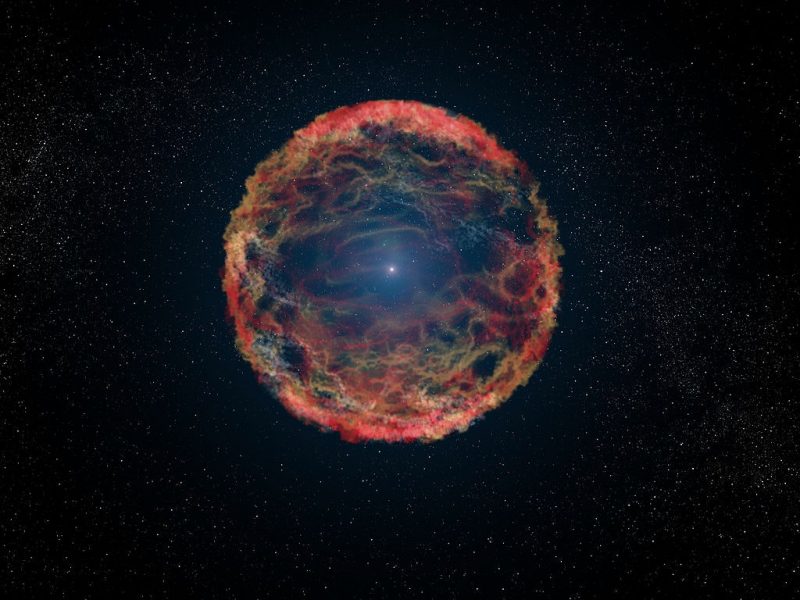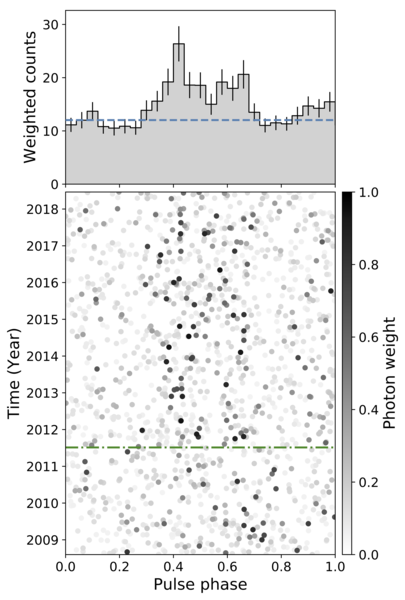
Supernova explosions can crush ordinary stars into neutron stars, composed of exotic, extremely dense matter. Neutron stars are on the order of about 12 miles (20 km) across in contrast to hundreds of thousands of miles across for stars like our sun. Yet they contain mass on the order of 1.4 times that of our sun. Neutron stars have strong magnetic fields. They emit powerful blasts of radiation along their magnetic field lines. If, as a neutron star spins, its beams of radiation periodically point towards Earth, we see the star as a pulsing radio or gamma-ray source. Then the neutron star is also called a pulsar, often compared to a cosmic lighthouse. Modern astronomers know of pulsars spinning with mind-boggling rapidity. The second-fastest one – called PSR J0952-0607 – spins some 707 times a second! Scientists at the Max Planck Institute for Gravitational Physics in Hanover, Germany announced on September 19, 2019, that this pulsar, J0952-0607 – formerly seen only at the radio end of the spectrum – now has been found to pulse also in gamma rays.
J0952-0607 – the number relates to the object’s position in the sky – was first discovered in 2017. It was originally seen to pulse in radio waves, but not gamma rays. The international team that studied it in detail – and recently published new work about it in the peer-reviewed Astrophysical Journal – said in a statement:
The pulsar rotates 707 times in a single second and is therefore the fastest spinning in our galaxy outside the dense stellar environments of globular clusters.

The astronomers said this pulsar is orbiting the common center of mass in 6.2 hours with a companion star. The companion is extremely lightweight, with a mass of only one-fiftieth that of our sun. The companion star may be tidally locked to the pulsar, just as Earth’s moon is tidally locked to Earth so that one side of the moon always faces Earth. If one side of the companion star always faces the pulsar, that side of the star would be heated by the pulsar’s gamma radiation. The astronomers said they think they are seeing the companion’s hot “day” side and cooler “night” side vary in brightness and color as the companion star and the pulsar orbit their common center of mass.
These details were made possible because, in this new study, the astronomers analyzed a lot of data about this pulsar and its companion. They used 8.5 years worth of data from NASA’s Fermi Gamma-ray Space Telescope, two years of LOFAR radio observations, plus observations from two large optical telescopes and gravitational-wave data from the LIGO detectors. The lead author of the new research is Lars Nieder, a Ph.D. student at the Albert Einstein Center (Max Planck Institute) in Hannover. Data analysis is one of his special areas of study. He commented:
This search is extremely challenging because the Fermi gamma-ray telescope only registered the equivalent of about 200 gamma rays from the faint pulsar over the 8.5 years of observations. During this time the pulsar itself rotated 220 billion times. In other words, only once in every billion rotations was a gamma ray observed!
For each of these gamma rays, the search must identify exactly when during each of the 1.4 millisecond rotations it was emitted.

According to these astronomers’ statement:
This requires combing through the data with very fine resolution in order not to miss any possible signals. The computing power required is enormous. The very sensitive search for faint gamma-ray pulsations would have taken 24 years to complete on a single computer core. By using the Atlas computer cluster at the AEI Hannover it finished in just two days.
The astronomers said they found surprises in the data. They were surprised, for example, to find no gamma-ray pulsations before July 2011. They said:
The reason for why the pulsar only seems to show pulsations after that date is unknown. Variations in how much gamma rays it emitted might be one reason, but the pulsar is so faint that it was not possible to test this hypothesis with sufficient accuracy. Changes in the pulsar orbit seen in similar systems might also offer an explanation, but there was not even a hint in the data that this was happening.
For now, the lack of gamma-ray pulsations before 2011 is a mystery.

The astronomers commented that rapidly spinning pulsars like J0952-0607 are probes of extreme physics. They said:
How fast neutron stars can spin before they break apart from centrifugal forces is unknown and depends on unknown nuclear physics. Millisecond pulsars like J0952-0607 are rotating so rapidly because they have been spun up by accreting matter from their companion. This process is thought to bury the pulsar’s magnetic field. With the long-term gamma-ray observations, the research team showed that J0952-0607 has one of the ten lowest magnetic fields ever measured for a pulsar, consistent with expectations from theory.
Bruce Allen, Nieder’s Ph.D. supervisor and director at the Albert Einstein Institute Hannover, added:
We will keep studying this system with gamma-ray, radio, and optical observatories since there are still unanswered questions about it. This discovery also shows once more that extreme pulsar systems are hiding in the Fermi LAT catalogue.
We are also employing our citizen science distributed computing project Einstein@Home to look for binary gamma-ray pulsar systems in other Fermi LAT sources and are confident to make more exciting discoveries in the future.

Bottom line: PSR J0952-0607 is spinning 707 times a second, making it the 2nd-fastest pulsar known and the fastest pulsar outside globular clusters. Astronomers just discovered this pulsar is emitting high-energy gamma rays.
Source: Detection and Timing of Gamma-Ray Pulsations from the 707 Hz Pulsar J0952?0607











